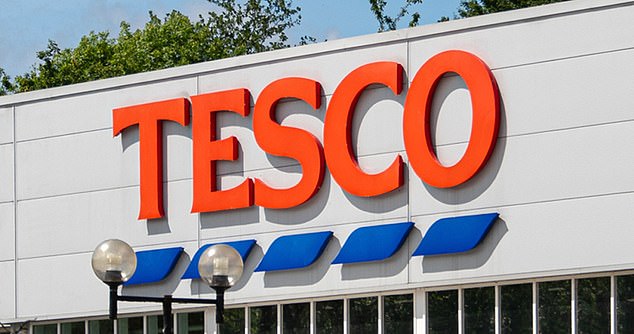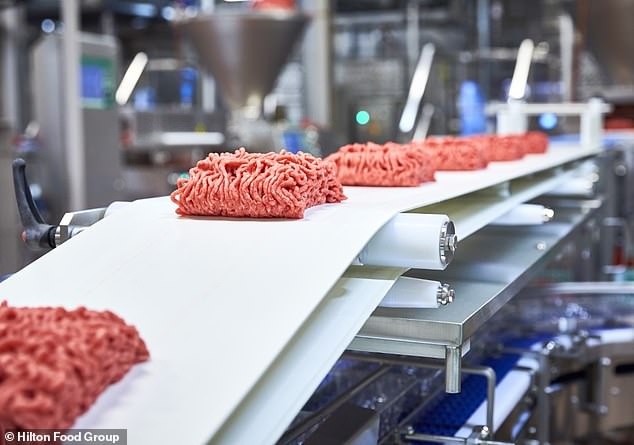Tesco shares are up 50%. Can you buy now and still make a profit? MIDAS SHARING TIPS
My grandfather was not a financial whiz kid. A family man with little interest in worldly goods, he bought one share all his life: Tesco.
My mother inherited his company in the early 1990s and still owns the shares to this day.
At the time, Tesco shares were below 70p. Today they cost £3.09, so Mum has done well and received plenty of dividends to boot.
Responsible: Tesco CEO Ken Murphy
But like many long-term owners, she looks back at the heyday of the Tesco share price in 2007, when the share hit £4.90, and wonders: will those glory days ever return?
Recent stock market performance has been promising. Shares are up 50 percent since September 2022, buoyed by rising sales, rising profits and rising confidence from CEO Ken Murphy.
Earlier this month, Murphy stated that Tesco is not only taking market share from its rivals, but customers are also shopping more often and buying more products when they do.
Independent data from supermarket guru Kantar proves Murphy’s point.
Tesco accounts for almost 28 percent of the UK food retail market, well ahead of Sainsbury’s at 15 percent, and also comfortably ahead of all other pretenders, including Aldi and Lidl.
Scale offers opportunities. The bigger Tesco becomes, the more influence Murphy has with suppliers, allowing him to keep prices low and profits high.
Clubcard is also an invaluable tool. The card, which has been in use for nearly three decades, identifies what shoppers like so Murphy can tailor its offerings and send special promotions to individual customers.

At the top: Tesco accounts for almost 28% of the UK food retail market
Tesco Finest provides extra bling as customers enjoy dishes such as Bourbon pulled beef and Sicilian pies.
The warmer weather and the euro provide a further boost, stimulating the purchase of firecrackers, beer and bottles of soft drinks.
Confidence is high. Brokers are targeting turnover of more than £69bn for the year to February 2025, with profits approaching £2.4bn and a dividend of 13.1p.
Steady growth is expected for the following year – turnover of over £70 billion, profits of over £2.5 billion and an increase in the dividend to 14.2p.
The group has also launched a new venture, Tesco Marketplace, a kind of wannabe Amazon, where customers can buy everything from patio furniture to personal blenders and puppy strollers in addition to the weekly grocery shop.
And earlier this year, Murphy sold Tesco Bank to Barclays for around £700 million, promising to use the money to buy back shares, a move designed to boost the share price.
Murphy can rightly be proud of recent achievements, but if you look a little further back, the picture is a bit more mixed.
Rising inflation and the cost of living crisis took their toll on Tesco, sending shares down to just £2.05 in September 2022.
Shareholders with long memories can also chart Tesco’s slow demise after the financial crisis, culminating in the 2014 accounting scandal, which saw the group make losses and be investigated by the Serious Fraud Office.
Fortunately, those dark days are far behind us and the future under Murphy seems much brighter.
After joining in 2020, the Irishman has won respect in the city for his work to date and his plans for the company. A recent £10 million pay package caused confusion in some quarters, but few would deny the value he delivers to investors, customers and employees alike.
Midas judgment: Tesco shares have had a strong run of late, but at £3.09 there should be plenty more growth to come.
Economic conditions are improving, Murphy is ambitious and customers are responding with their wallets. Existing shareholders must stick with it. New investors could even grab a few and hope the shares head towards the golden days of 2007.
Powerful machine keeps the shelves full
Fancy throwing some Tesco steaks on the barbecue this weekend? There’s a good chance they come from Hilton Food Group.
Hilton has been supplying Tesco with red meat cuts for 30 years and the relationship is stronger than ever. Initially focusing on beef and lamb in Britain, Hilton now also works with Tesco in Ireland and Central Europe and the range runs from prime steak to mince, fish cakes to fillets and many refined ready meals.

Strong bond: Hilton has been supplying Tesco with red meat cuts for 30 years
Tesco accounts for around a quarter of Hilton’s revenue, but the group has spent the past two decades acquiring major customers abroad, adding new products and leading the charge in technology and innovation .
Robots are now used to cut and package meat. Data specialists convert consumer preferences into tasty recipes. High-speed water jets cut the salmon into neat small portions. Even fish cakes are made with machines.
Reliability, efficiency and smart ideas helped Hilton achieve steady growth for years.
However, in 2022, rising inflation and energy prices hit Hilton hard, especially its emerging fishing business. Two profit warnings followed and the shares fell from £12.42 to £5.40 within months.
Steve Murrells was appointed as an advisor and became CEO in July 2023. As boss of the Co-op from 2012, Murrells is credited with turning that company from an equally run business into one of Britain’s best-loved grocers. Now he is rolling up his sleeves at Hilton.
The fishmonger is running at full speed after an overhaul of production in Grimsby. Profits rose 20 percent to £66 million in 2023 and agents expect continued growth this year, with profits of £78 million and a 6 percent increase in dividend to 33.8p.
Murrells is also ambitious and hopes to win more business from Tesco and long-term partners, while attracting new customers.
Midas judgment: Midas first looked at Hilton Food Group in 2008, when the stock was just £1.70.
Today, Hilton Food Group shares are £8.99, a strong recovery from the 2022 lows, but still a long way from their peak. That should change. Murrells learned his trade under legendary Tesco boss Sir Terry Leahy and Hilton shareholders should benefit.
Burn’s pockets full of potential
Coral Products is a small plastics company based in Haydock, Merseyside.
But the company has a number of high-profile customers including Tesco, BT and the Ministry of Defense.
Coral supplies Tesco with foil to keep bread and rolls fresh, and CEO Lance Burn is keen to expand the relationship.
Just last week, Tesco buyers were in Haydock, viewing new Coral goods such as salad bags and dried fruit pouches, which in the past had come from India. Merseyside is a lot closer to home, a clear advantage.
Burn is new at Coral. Fresh from turning around giftware group IG Design, he arrived in January and had to issue a profit warning three weeks later.
Since then he has been hard at work simplifying the group into two divisions. Flexible plastics include food packaging and biodegradable pint glasses, much loved at football matches.
Rigid products are more industrial, from pipes for telecom cables to recycled decking for barracks.
Burn’s strategy is starting to yield results.
A trading update this month was encouraging and brokers expect decent growth in sales and profits for the full year to April, in addition to a dividend of at least 0.5p.
Midas judgment: Coral products has had a tough time in the stock market, falling nearly 20 percent to 13 cents in the past year alone. Burn is determined to get this British manufacturer back on its feet. The early signs are promising and stocks should respond accordingly. To buy.
Some links in this article may be affiliate links. If you click on it, we may earn a small commission. That helps us fund This Is Money and keep it free to use. We do not write articles to promote products. We do not allow a commercial relationship to compromise our editorial independence.
